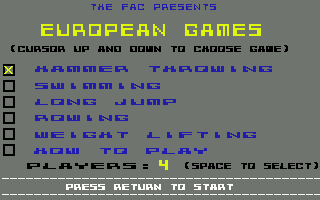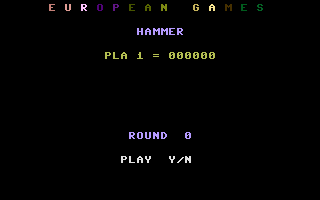Retro Replay Review
Gameplay
European Games offers a collection of joystick-intensive mini-events that test your reflexes and timing across multiple sporting disciplines. From the moment you pick up the joystick, you’ll be waggling left and right to simulate cycling or swimming, while power-bar mechanics challenge your precision in events like hammer throwing and weightlifting. The core loop is simple yet engaging: master the timing of button presses for power-based events and perfect your joystick motions for speed-based challenges.
(HEY YOU!! We hope you enjoy! We try not to run ads. So basically, this is a very expensive hobby running this site. Please consider joining us for updates, forums, and more. Network w/ us to make some cash or friends while retro gaming, and you can win some free retro games for posting. Okay, carry on 👍)
The variety of events keeps the gameplay fresh, especially given the slightly different discipline roster on each platform. On the Commodore, you’ll enjoy extra rotation control in the hammer throw and a rowing event that adds a unique twist to the “Games” formula. Meanwhile, the MSX version swaps in shooting and cycling events that demand both strategic positioning and rhythmic button timing as the accuracy bar climbs.
Each discipline follows its own ruleset but generally divides into two categories: speed events driven by rapid left-right joystick movements and precision events governed by power bars. For example, in shooting, you first line up your athlete, then hit the trigger at the peak of the accuracy meter—miss the timing and you’ll watch your shot veer off target. In the long jump, you must gauge your run-up speed via the joystick and press the jump button at the exact moment you hit the take-off board, with an optional angle adjustment adding further depth.
The learning curve is moderate: initial attempts can feel like frantic joystick-churning, but as you internalize each event’s mechanics and cadence, performance improves markedly. Mastering the power bar timing in weightlifting and hammer throw, or the careful management of air supply in swimming, provides satisfying “aha” moments. Multiplayer adds a competitive edge, letting you challenge friends to see who can set the best times or highest scores across the European Games disciplines.
For players seeking depth, the Commodore version’s added rotational control and exclusive events deepen the challenge, rewarding practice and fine motor skills. On the MSX, the emphasis on precise trigger timing and sustained joystick pumping for cycling keeps adrenaline levels high. Either way, European Games balances simple controls with nuanced event-specific tactics, ensuring both pick-up-and-play fun and opportunities for mastery.
Graphics
European Games presents a colorful, cartoonish aesthetic typical of mid-’80s sports compilations. On both the MSX and Commodore, athletes are rendered as chunky, expressive sprites that communicate movement clearly, even if they lack intricate detail. The backgrounds are minimal—just enough to suggest a stadium or open field—keeping the focus squarely on the action and maintaining smooth frame rates during frantic input sequences.
Animation is serviceable rather than spectacular. In cycling and swimming, the repeated left-right sweeps of the sprite arms and legs convey motion effectively, while throwing and weightlifting show clear, if limited, power-bar builds. The Commodore’s version edges ahead with slightly smoother transitions and more detailed rotational frames when spinning the hammer, whereas the MSX version compensates with snappier shooting animations and a crisp power-meter overlay.
Visual feedback is well-implemented: power bars flash at the top to cue your button press, air supply meters in swimming blink as you approach zero, and on-screen prompts remind you when to adjust jump angle or rotate the hammer. While the resolution is low by modern standards, the bright color palette and bold UI elements ensure each event’s objectives are immediately apparent.
Platform-specific quirks add personality. The MSX’s shooting reticle movement feels a bit more responsive, and the accuracy bar glows distinctively when you’re near perfect aim. On the Commodore, rowing and hammer-throw rotations animate at different speeds depending on joystick input, giving a tactile sense of control that seasoned players will appreciate. These small details elevate the presentation above mere sprite-shuffling.
Overall, European Games doesn’t aim for photorealism but succeeds in providing clear, enjoyable visuals that support quick-and-dirty sports action. If you value legibility, bright colors, and playful character designs over elaborate graphical fidelity, this title’s aesthetic will feel right at home.
Story
European Games is not a narrative-driven title; it drops you straight into a series of sporting events with only the mildest pretense of an overarching competition. There’s no cast of characters to follow or dramatic plot twists to unfold—just a relentless push for medals across a handful of classic Olympic-style disciplines. The lack of storyline is by design, emphasizing instant engagement over storytelling depth.
Despite the absence of cutscenes or dialogue, the game implicitly tells the story of an underdog athlete striving for victory against the clock and opponents. Each medal you earn serves as a small narrative beat, marking your progress through the virtual stadium stands and cheering crowds. The sense of personal achievement in mastering each discipline becomes its own story arc.
The user interface provides minimal context: event names, best times or distances, and simple podium icons replace traditional story exposition. For players accustomed to sports games, this stripped-down approach may feel familiar and welcome. Others seeking character-driven drama might miss cutscenes or rival athletes with dialogue, but those looking purely for athletic challenge won’t be disappointed.
European Games relies on the universal appeal of competition rather than a scripted scenario. In this sense, the player writes their own story—working through failures, refining techniques, and celebrating incremental improvements. Though the game offers no behind-the-scenes lore or backstory, the competitive spirit shines through every joystick waggle and timed button press.
Ultimately, the “story” you experience in European Games is defined by your own journey to mastery. Each retry, each personal best, and each podium finish stitches together a narrative of perseverance and skill—one that doesn’t require dialogue or plot, only your determination to outpace the clock and out-throw your rivals.
Overall Experience
European Games stands out as a quintessential example of mid-1980s multi-event sports titles. Its pick-up-and-play accessibility makes it ideal for quick gaming sessions, while the depth hidden in precision timing and joystick stamina offers long-term engagement for dedicated players. Whether you’re pressing a trigger at the perfect millimeter of a power bar or furiously waggling to simulate rowing or cycling, each event delivers its own brand of arcade-style excitement.
The platform variations between MSX and Commodore add replay value, encouraging players to sample both versions if possible. Exclusive events and control nuances give each release a slightly different feel, ensuring that mastering one version doesn’t automatically translate to flawless performance on the other. Local multiplayer enhances the fun, turning living rooms into makeshift arenas for button-mash battles and reflex contests.
While the lack of narrative depth may deter those seeking a story-rich experience, European Games succeeds brilliantly as a pure sports compilation. The clear visual design, intuitive UI cues, and tight event packs keep the focus on personal skill and improvement. The challenge curve is fair—early events introduce core mechanics gently, while later rounds demand split-second reactions and precise joystick maneuvers.
The game’s enduring appeal lies in its simplicity and competitive spirit. It captures the feel of athletic contests without unnecessary complexity, making it easy for newcomers to jump in while still rewarding practice and finesse. For retro gaming enthusiasts and fans of classic sports simulations, European Games offers a charming, well-paced experience that remains engaging decades after its release.
In summary, European Games delivers a robust collection of sporting challenges wrapped in straightforward mechanics, bright visuals, and satisfying feedback systems. It may not tell an elaborate story, but it lays down a gauntlet of events that beckon players to improve, compete, and celebrate each hard-earned medal. If you’re in the market for a crisp, competitive sports compilation with varied gameplay and solid replayability, European Games is well worth your time.
 Retro Replay Retro Replay gaming reviews, news, emulation, geek stuff and more!
Retro Replay Retro Replay gaming reviews, news, emulation, geek stuff and more!









Reviews
There are no reviews yet.